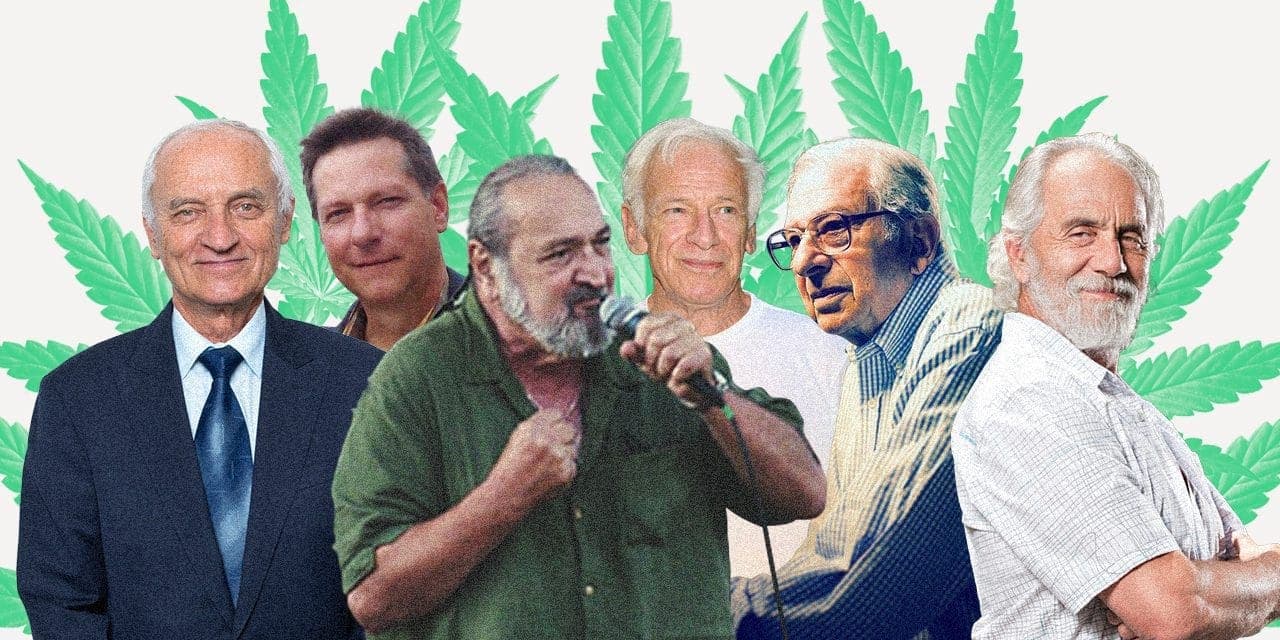Five Fathers of Legal Modern Medical Cannabis

Article written by

Dipak HemrajMedical Cannabis Researcher
Content reviewed by

Dr. Lewis Jassey
Each of these celebrated cannabis men, or team of men, has been a progenitor of cannabis science, legality, or normalization. Much of America’s steady evolution toward cannabis legalization and legitimizing cannabis medical products as scientifically recognized therapeutic substances has descended from Leafwell’s band of cannabis dads.
Get your medical marijuana card
Dennis Peron: The Father of California’s Medical Cannabis Law
By the time he died in 2018, Dennis Peron had seen his vision of legal, medical marijuana readily available to anyone suffering from a chronic medical issue come true. A pioneering AIDS activist operating out of San Francisco in the 1980s, Peron launched a Cannabis Buyers’ Club in 1996, based on the template of AIDS drug buyers’ clubs of the time.
Before the AIDS pandemic, Peron had been selling marijuana semi-openly through the 1970s and ’80s. When his partner, Jonathan West, contracted the virus, Peron lasered his focus on providing medical marijuana for anyone in his community who had fallen prey to the virus. In the early stages of the AIDS plague, contracting HIV was a virtual death sentence, with many infected wasting away because they couldn’t eat. The “raging munchies” produced by cannabis became a highly valued side effect.
Peron was arrested in the Castro neighborhood of San Francisco in 1991. He and Jonathon West stood trial for possession and use of marijuana. Two weeks after their trial ended, Jonathan died.
Seeking revenge for his partner’s ordeal, Peron gathered signatures to place a “Hemp Medications” proposition on a San Francisco City ballot that passed with 78 percent voter approval. After the San Francisco victory, the campaign for Proposition 215, or the Compassionate Use Act of 1996, which passed with 56 percent approval, establishing California as the country’s pioneer legal, medical marijuana state, was launched by a coalition of patients, suppliers, and activists at the downtown San Francisco headquarters of Dennis Peron’s Cannabis Buyers’ Club.
Lumír Hanuš and William Devane: The Fathers of the Endocannabinoid System
Czech analytic chemist Dr. Lumír Ondřej Hanuš and American researcher Dr. William Devane discovered the key to unlocking the healing potential of the cannabis plant in 1992 while working together at the Hebrew University in Jerusalem. The two scientists were the first to describe the structure of anandamide, which makes up an integral part of the endocannabinoid system (ECS), a web of nerve receptors that acts as a molecular signaling network, stimulating chemical responses to regulate biological functions and stabilize imbalances within the human body.
The discovery of how the ECS cellular messaging network operates cleared up much of the mystery of why so much anecdotal evidence exists of medical marijuana providing effective relief for a wide range of persistent and recurring health conditions. Professors Raphael Mechoulam, Roger Pertwee, Dr. Hanuš, and Dr. Devane (and Dr. Allyn Howlett) have made some of the most significant contributions to our understanding of the ECS.
Lester Grinspoon: The Father of Marijuana as Medicine
Psychiatrist Lester Grinspoon published Marihuana Reconsidered in 1971 with the Harvard University Press. Proclaimed “the best dope on pot so far” by the New York Times, Grinspoon’s book dismantled decades of official misinformation that painted “marihuana” as a dangerous substance of no social value, suitable only for inciting violence, insanity, and sex parties. Grinspoon questioned the legal status of marijuana, urged the close study of the cannabis plant’s medicinal properties, and suggested responsible marijuana usage might provide psychological benefits.
Grinspoon followed up the groundbreaking Marijuana Reconsidered with Marihuana, the Forbidden Medicine, which along with his 40 years as a senior psychiatrist at the Massachusetts Mental Health Center and as a board member of the National Organization for the Reform of Marijuana Laws (NORML), have left a tall legacy of advocacy for marijuana legalization and medical applications.
Jack Herer: The Father of Cannabis as an Industrial Cure All
Perhaps better known to casual marijuana consumers as the name of a prized cannabis strain, Jack Herer was an ancestral advocate (died in 2010) for commercial use of hemp fiber, a case that he argued in his 1985 book, The Emperor Wears No Clothes: Hemp and the Marijuana Conspiracy.
The Hemperor, as Jack became known, started his book in 1973, compiling a formidable stack of facts regarding the cannabis plant’s massive spectrum of utility. Twelve years later, Herer’s epic argument for the value of hemp was printed on hemp paper with a hemp-inclusive central thesis:
If all fossil fuels and their derivatives, as well as trees for paper and construction, were banned in order to save the planet, reverse the Greenhouse Effect and stop deforestation; then there is only one known annually renewable natural resource that is capable of providing the overall majority of the world’s paper and textiles; meet all of the world’s transportation, industrial and home energy needs, while simultaneously reducing pollution, rebuilding the soil, and cleaning the atmosphere all at the same time… and that substance is Cannabis Hemp… Marijuana!
Herer offered a $100,000 reward to anyone who could prove his cannabis contentions were a lie, $100,000 that so far no one has been able to collect.
Tommy Chong: The Father of Cannabis Image Makeover
Tommy Chong and Cheech Marin are half of the marijuana world’s most famous and celebrated comedy team. Two of the 1970s most bankable movie stars with a string of hit art house films, including Up in Smoke (1978), Cheech & Chong’s Nice Dreams (1981), and Still Smokin’ (1983), the pair forever established the bumbling, open-hearted stoner stereotype. Keeping in mind that Chong’s credentials for modern cannabis patriarch include a nine-month prison stint for running a bong business, his more significant cultural influence may be, as argued by L.A. Weekly writer Michael Goldstein, that “these essentially benign portrayals showed cannabis users as harmless or even lovable, a 180-degree turn from the menacing, sex-crazed marijuana demons in films such as Reefer Madness.


